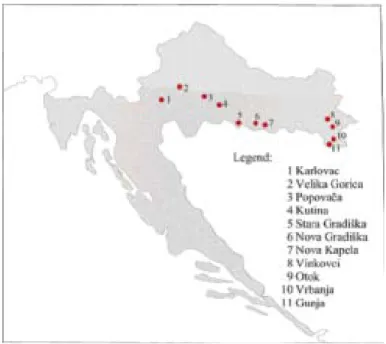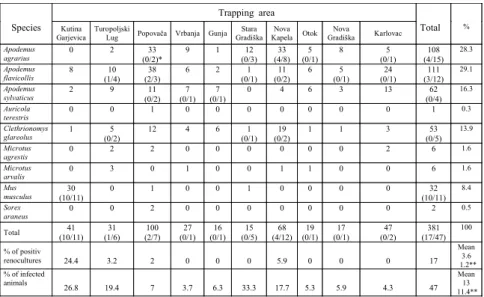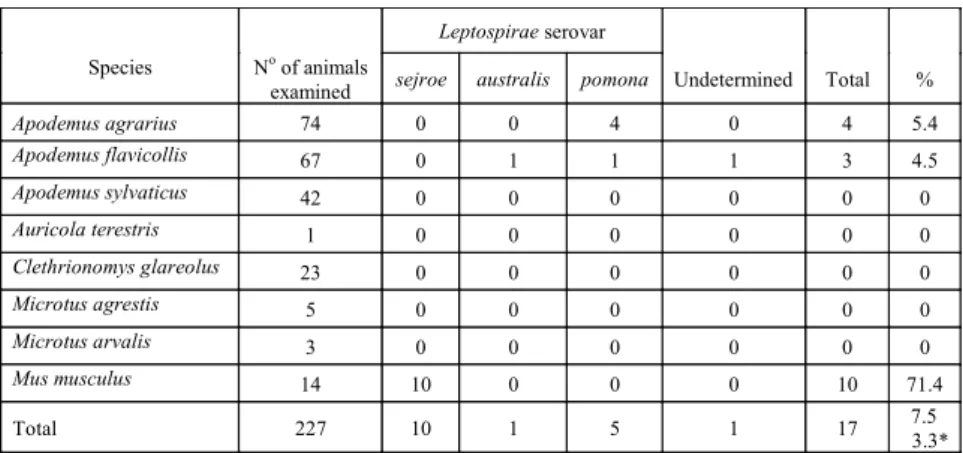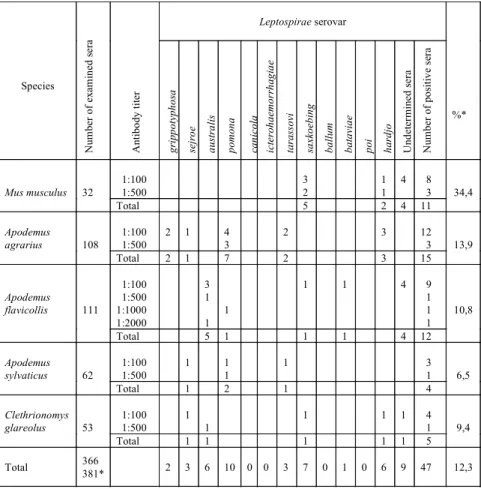119
VETERINARSKI ARHIV 72 (3),119-129, 2002
*Contact address:
Dr. Zoran Milas, Department of Microbiology and Infectious Diseases, Faculty of Veterinary Medicine, University of Zagreb, Heinzelova 55, HR-10000 Zagreb, Croatia, Phone and Fax: +385 1 23 90 211; E-mail: laboratorij-iak@zg.tel.hr
The role of myomorphous mammals as reservoirs of leptospira
in the pedunculate oak forests of Croatia
Zoran Milas1*, Nenad Turk1, Vilim Starešina1, Josip Margaletić3,
Alen Slavica2, Dragica Živković1, and Zvonko Modrić1
1Department of Microbiology and Infectious Diseases, Faculty of Veterinary Medicine,
University of Zagreb, Croatia
2Chair for Game Biology, Pathology and Breeding, Faculty of Veterinary Medicine,
University of Zagreb, Croatia
3Department of Forest Protection and Wildlife Management, Faculty of Forestry,
University of Zagreb, Croatia
MILAS, Z., N. TURK, V. STAREŠINA, J. MARGALETIĆ, A. SLAVICA, D.
ŽIVKOVIĆ, Z. MODRIĆ:The role of myomorphous mammals as reservoirs of
leptospira in the pedunculate oak forests of Croatia. Vet. arhiv 72, 119-129, 2002.
ABSTRACT
In the year 2000, three hundred and eighty-one animals werw caught in 11 locations in the pedunculate oak forests extending across the wider region of the Sava River valley, an area known as an old natural focus of leptospires. Two hundred and twenty-seven animals were investigated for leptospiral carriership, 381 were tested for the existence of specific antibodies to leptospira. Through cultivation of kidney sections in the Korthof’s nutrient medium, 17 strains of leptospira were isolated from 3 species of myomorphous mammals, of which in the
house mouse (Mus musculus) the serovar sejroe in 10 animals (71.4%), in the black-striped
field mouse (Apodemus agrarius) the serovar pomona in 4 animals (5.4%) and in the
yellow-necked field mouse (Apodemus flavicollis) the serovars australis, pomona and one unindentified
isolate in 3 animals (4.5%), representing a total of 7.5% of animals. Using the microscopic agglutination test in 47 animals (12.3%), antibodies to leptospira were found for 8 serovars, for
the most part the serovar pomona, then (in decreasing order) for the serovars saxkoebing
australis, and hardjo. The percentage of serologically positive animals ranged from 34.4% in the house mouse, 13,9% in the black-striped field mouse, 10.8% in the yellow-necked field
mouse, 9.4% in the bank vole (Clethrionomys glareolus), to 6.5% in the long-tailed field mouse (Apodemus sylvaticus). The research results suggest that pedunculate oak forests can be considered as an integral part of a vast natural focus of leptospirosis. The specificity and role of this biotope in maintaining leptospira should be investigated to a greater extent in the future.
Key words: leptospira, myomorphous mammals, natural foci
Introduction
The life cycle of leptospira is maintained by circulation in nature among wild animals, which classifies leptospirosis in the group of diseases with
natural foci (BABUDIERI, 1958). Previous investigations into the geographical
extensions of natural foci of leptospirosis in Croatia relied either on general
knowledge of epizootiology of leptospirosis (ZAHARIJA, 1968), or on facts
collected on the spread of leptospirosis among humans (BORČIĆ et al., 1978;
BORČIĆ, 1982; BORČIĆ et al.,1988). The object of this study is to explore the
role of myomorphous mammals in maintaining the natural foci of leptospirosis in eco systems of pedunculate oak forests, the ecological relations among serological varieties of leptospira and myomorphous mammals, and to compare the results with those obtained 20 years ago in investigating the natural foci of leptospirosis.
Materials and methods
In order to collect myomorphous mammals for isolation of leptospira and for serological tests for leptospira, from March through November 2000, animals were trapped in 11 locations of the pedunculate oak stands:
at Karlovac, Turopoljski Lug, Kutina-Garjevica, Popovača, Nova Gradiška,
Stara Gradiška, Nova Kapela, Vinkovci, Gunja, Vrbanja and Otok (Fig. 1). The animals were collected by standard method of linear transect by means of Sherman type snapping traps and Museum special dead traps placed linearly 5 to 7 m apart (50 at a time). The traps were placed at sunset, to be emptied the following morning. During March, April, May, June, July, October, November and December, 30 hunts were organized on micro locations believed to suit the habitat of target animals. The only exception was the Kutina-Garjevica location, chosen as an example of intensive wildlife breeding ground in a spatially limited forest area. Trapped animals were identified and sorted on site and sent for microbiological testing
Z. Milas et al.: Myomorphous mammals as reservoirs of leptospira in pedunculate oak forests
within a few hours, 16 hours at most. Trapped live animals were euthanized and dissected under sterile conditions. For serological tests 0.5 ml of blood was taken by Pasteur’s pipette from the heart of live-trapped animals, whereas from dead-trapped animals the whole heart was taken. Serological
tests were conducted by the microscopic agglutination test (GOCHENOUR
et al., 1958) with 12 L. interrogans serovars: grippotyphosa, sejroe, australis, pomona, canicola, icterohaemorrhagiae, tarassovi,
saxkoebing, ballum, bataviae, poi and hardjo. Blood sera were examined at a basic dilution of 1:100 for listed leptospira serovars, whereas positive sera were examined for corresponding leptospira serovars up to the final
dilution titre of 50% agglutination. Microagglutination antibody titre ≥1:100
was considered as an indicator of earlier infection. If the serum was positive to two or more leptospira serovars, the serovar with the highest antibody titre was considered the infective agent. Taken into account in evaluating these findings was the discovered likelihood that occasional cross-reactivity
among serovars may result in an equal or even higher antibody titre (MODRIĆ
et al., 1985). A tissue section was taken from each mouse with Pasteur’s
pipette from the cortex of the kidney and inoculated in two test tubes with
5 ml of Korthof’s medium in each (BABUDIERI, 1961). Inoculated Korthof’s
media were incubated at 28 0C, with the growth of leptospira being controlled
under a dark-field microscope at weekly intervals. The result of isolation was considered negative if leptospira were not found on day 35. Isolated leptospira strains were identified by microscopic agglutination reaction to
antisera of reference leptospira strains of 12 serogrups:
ictero-haemorrhagiae, javanica, canicola, ballum, pyrogenes, autumnalis,
australis, pomona, grippotyphosa, hebdomadis, bataviae and tarassovi.
Results
The results of the investigations are shown in Tables 1-3.
Table 1 indicates that out of the 381 trapped animals the following
species prevail: the yellow-necked field mouse (Apodemus flavicollis)
Table 1. Specification of myomorphous mammals examined by renoculture and microscopic agglutination according to the trapping area, with corresponding results
* Numbers in brackets represent positive findings, the first by renoculture and the second by microscopic agglutination
** Mean value after separating the results of Kutina-Garjevica trapping area
Trapping area Species Kutina
Garjevica Turopoljski
Lug Popovača Vrbanja Gunja Stara Gradiška Nova Kapela Otok Nova Gradiška Karlovac Total % Apodemus agrarius 0 2 (0/2)* 33 9 1 12 (0/3) 33 (4/8) 5 (0/1) 8 5 (0/1) 108 (4/15) 28.3 Apodemus flavicollis 8 (1/4) 10 38 (2/3) 6 2 1 (0/1) 11 (0/2) 6 5 (0/1) 24 (0/1) 111 (3/12) 29.1 Apodemus sylvaticus 2 9 (0/2) 11 7 (0/1) 7 (0/1) 0 4 6 3 13 62 (0/4) 16.3 Auricola terestris 0 0 1 0 0 0 0 0 0 0 1 0.3 Clethrionomys glareolus 1 (0/2) 5 12 4 6 (0/1) 1 (0/2) 19 1 1 3 (0/5) 53 13.9 Microtus agrestis 0 2 2 0 0 0 0 0 0 2 6 1.6 Microtus arvalis 0 3 0 1 0 0 1 1 0 0 6 1.6 Mus musculus (10/11) 30 0 1 0 0 1 0 0 0 0 32 (10/11) 8.4 Sorex araneus 0 0 2 0 0 0 0 0 0 0 2 0.5 Total (10/11) 41 (1/6) 31 (2/7) 100 (0/1) 27 (0/1) 16 (0/5) 15 (4/12) 68 (0/1) 19 (0/1) 17 (0/2) 47 (17/47) 381 100 % of positiv renocultures 24.4 3.2 2 0 0 0 5.9 0 0 0 17 Mean 3.6 1.2** % of infected animals 26.8 19.4 7 3.7 6.3 33.3 17.7 5.3 5.9 4.3 47 Mean 13 11.4**
Z. Milas et al.: Myomorphous mammals as reservoirs of leptospira in pedunculate oak forests
29.2%, the black-striped field mouse (Apodemus agrarius) 28.3%, the
long-tailed field mouse (Apodemus sylvaticus) 16.3%, the bank vole
(Clethrionomys glareolus) 13.9 %, the house mouse (Mus musculus) 8.4%. The leptospira isolation results demonstrate the following distribution of animal hosts in relation to the trapping area: Kutina-Garjevica 24.4%,
Nova Kapela 5.9%, Turopoljski Lug 3.2%, Popovača 2%. Average
carriership in the trapping areas amounted to 3.6%. The percentages of infected animals by trapping area were as follows: Stara Gradiška 33.3%, Kutina-Garjevica 26.8%, Turopoljski Lug 19.6%, Nova Kapela 17.7%,
Popovača 7%, Gunja 6.3%, Nova Gradiška 5.9%, Otok 5.3%, Karlovac
4.3%, Vrbanja 3.7%. The average leptospira infection rate was 13%. A total of 17 animal hosts and 47 infected animals were identified. No animals were trapped in the Vinkovci area.
Table 1. Specification of myomorphus mammals examined by renoculture and microscopic agglutination acording to the trapping area with corresponding results
Table 2 shows the results of leptospira isolation from renoculture in relation to the examined animal species. Leptospira were isolated from 17 animals out of 227, belonging to three species: the house mouse (10), the black-striped field mouse (4) and yellow-necked field mouse (3). The percentage of carriers in relation to the number of animals examined ranged
Table 2. Distribution of isolated leptospiral serovars in relation to the animal-host species
* Percentage of carriers decreased by results of Kutina-Garjevica trapping area
Leptospirae serovar
Species No of animals
examined sejroe australis pomona Undetermined Total %
Apodemus agrarius 74 0 0 4 0 4 5.4 Apodemus flavicollis 67 0 1 1 1 3 4.5 Apodemus sylvaticus 42 0 0 0 0 0 0 Auricola terestris 1 0 0 0 0 0 0 Clethrionomys glareolus 23 0 0 0 0 0 0 Microtus agrestis 5 0 0 0 0 0 0 Microtus arvalis 3 0 0 0 0 0 0 Mus musculus 14 10 0 0 0 10 71.4 Total 227 10 1 5 1 17 7.5 3.3*
from 71.4% in the house mouse, 5.4% in the black-striped field mouse, to
4.5% in the yellow-necked field mouse. Leptospira of serovar sejroe were
isolated from the house mouse, serovar pomona from the black-striped
field mouse, serovar australis and pomona from the yellow-necked field
mouse, whereas one isolate remained unidentified. A total of 17 animals (7.5%) were carriers.
Table 3. Number and percentage of sera with antibodies to leptospires according to the animal-host species Leptospirae serovar Species N um ber o f ex am in ed s er a A ntib od y tit er gr ip po ty phos a se jr oe au st ra lis po m ona ca ni co la ic te ro ha em or rh ag ia e ta ra ss ov i sa xko eb in g ba llu m ba ta vi ae po i ha rd jo U nd et er min ed s er a N um be r of po si tiv e s er a %* 1:100 1:500 3 2 1 1 4 8 3 Mus musculus 32 Total 5 2 4 11 34,4 1:100 1:500 2 1 4 3 2 3 12 3 Apodemus agrarius 108 Total 2 1 7 2 3 15 13,9 1:100 1:500 1:1000 1:2000 3 1 1 1 1 1 4 9 1 1 1 Apodemus flavicollis 111 Total 5 1 1 1 4 12 10,8 1:100 1:500 1 1 1 1 3 1 Apodemus sylvaticus 62 Total 1 2 1 4 6,5 1:100 1:500 1 1 1 1 1 4 1 Clethrionomys glareolus 53 Total 1 1 1 1 1 5 9,4 Total 366 381* 2 3 6 10 0 0 3 7 0 1 0 6 9 47 12,3
* Number and percentage of sera with antibodies to leptospirae according to the total number of examined sera
Z. Milas et al.: Myomorphous mammals as reservoirs of leptospira in pedunculate oak forests
Table 3 shows the leptospira antibodies finding in sera of the examined animals. Antibodies were identified to 8 leptospira serovars, in 5 animal species: the house mouse, in 11 animals (34.4%); the black-striped field mouse, in 15 animals (13.9%); the yellow-necked field mouse, in 12 animals (10.8%); the long-tailed field mouse, in 4 animals (6.5%); the bank vole, in 5 animals (9.4%). In the house mouse sera, antibodies to leptospira at
highest titre were found for serovar saxkoebing and hardjo, in the
black-striped field mouse for serovars grippotyphosa, sejroe, pomona,
icterohaemorrhagiae, tarassovi and hardjo, in the yellow-necked field
mouse for serovars australis, pomona, saxkoebing and bataviae, in the
long-tailed field mouse for serovars australis, pomona, saxkoebing and
bataviae, in the bank vole for serovars sejroe, australis, saxkoebing and
hardjo. A total of 47 infected animals (12.3%) was found.
Discussion and conclusions
Analysis of trapped myomorphous mammals indicates that the following species prevailed in the total number of trapped animals: yellow-necked field mouse 29.1%, black-striped field mouse 28.3%, long-tailed field mouse 16.3%, bank vole 13.9%. Prevalence of species in relation to the trapping area is, on the whole, evenly distributed, with the exception of the Kutina-Garjevica trapping area. In their investigation of the range of natural
leptospirosis foci in the Kupa and Sava River valleys, BORČIĆ et al. (1978)
and BORČIĆ (1982) indicate as the prevailing species the common vole
(Microtus arvalis) and the black-striped field mouse, followed by common vole and long-tailed field mouse. A comparison of results indicates a variance in the prevalence of species, especially in respect of the yellow-necked field mouse, the bank vole and, partially, the long-tailed field mouse. This is probably due to the fact that our investigation was confined to an area of pedunculate oak forests where the yellow-necked field mouse, the long-tailed field mouse and the bank vole are more numerous, whereas in the previous investigation the author’s aim was to investigate the greatest possible number of biotopes, so animals were trapped in fields, meadows, by water courses, canals, embankments and in groves. The strong presence of the house mouse in the area of Kutina-Garjevica hunting grounds is due
to intensive breeding of wild boars and wild ruminants introduced by man into a relatively small and limited area within a large forest complex. The results of leptospira isolation reflect to a great extent the structure of trapped
animals. Of the 17 leptospira isolates, 10 belong to the serovar sejroe isolated
from the house mouse, 5 to serovar pomona isolated from black-striped
field mouse (4) and yellow-necked field mouse (1), one to the serovar
australis isolated from the yellow-necked field mouse and one unidentified
(possibly serovar australis) from the yellow-necked field mouse. The
percentage of leptospira carriership relative to species ranged from 4.5% in the yellow-necked field mouse to as high as 71.4% in the house mouse. Average leptospira carriership was 7.5%, but if we separate the house mouse as a “strayed species” in the forest biotope, then the average
leptospira carriership would be 3.3%. BORČIĆ et al. (1978; 1982) during two
investigations in the Sava River valley identified leptospira carriership in the long-tailed field mouse at the rate of 10.9% and 10.8%, respectively; the common vole 14.3%, the meadow mouse 25% and 12.9%, respectively; the black-striped field mouse 31.3% and 18.5%, respectively; the bank vole 26.6% and 17.2%, respectively; the yellow-necked field mouse 42.8%; on average, 20.9% and 15.8%, respectively. The results of investigating the relation of the species to isolated leptospira serological variants were anticipated and reflect the alreadyknown fact that the house mouse is the
prevailing host to the serovar sejroe, the black-striped field mouse to the
serovar pomona, and the yellow-necked field mouse to the serovar australis
(BABUDIERI, 1958; BORČIĆ et al., 1978; 1986). Leptospira carriership of
examined animals by location ranged from 2% to 24.4%, on average 3.6%
and 1.2%, respectively. The results of leptospira isolation would probably
be higher were it not for the difficulties in the trapped animals’ treatment due to high daily temperature. The results of microscopic agglutination test support the isolation findings. Antibodies were isolated to 10 leptospira
serologic variants, most often the serovars pomona, saxkoebing and
australis, whereas other results were sporadic. The relation between host and leptospira serovar is serologically confirmed by the fact that in the
house mouse sera antibodies were found to serovars saxkoebing and
hardjo, in the black-striped field mouse mostly to the serovar pomona, in
Z. Milas et al.: Myomorphous mammals as reservoirs of leptospira in pedunculate oak forests
results is the additional fact that we had 9 sera with equal titre of antibodies to two or more leptospira serovars, but their serological findings correspond to the predisposed species. Infection by leptospira in relation to species ranged from 6.5% in the long-tailed field mouse to 13.9% in the black-striped field mouse and 34.4% in the house mouse, respectively. Average infection was 12.6%, and upon separation of the house mouse findings, 10.9% of examined animals. Location-related infection ranged from 3.7% to 33.3%, on average 13% and 11.4% respectively. The results of serological
tests in the investigation conducted by BORČIĆ (1982) demonstrated 3.8%
infection in the long-tailed field mouse, 7.6% in the common vole, 12.7% in the bank vole, 20% in the yellow-necked field mouse, 24.1% in the black-striped field mouse, 31.6% in the meadow mouse, (average of 15.1%). Investigations into the range of natural leptospirosis foci in the regions of Central Europe with similar pedologic and climatic characteristics have
yielded similar results. Over a span of four years TREML and NESNALOVA
(1993) serologically screened 4634 specimens of 10 myomorphous mammal species in the Czech Republic and found average infection in 12.1% of animals: 6.1% in the common vole, 3.4% in the long-tailed and the
yellow-necked field mice. STANKO et al. (1997) serologically screened 2113 animals
of 5 myomorphous mammal species in the region of eastern Slovakia and
found antibodies to serovar grippotyphosa (65.1%) and serovar sejroe
(25.5%) in 5 % of animals. By comparing these investigations we can conclude that the results of our study are comparable to those of earlier investigations into natural foci of leptospirosis of similar characteristics. The frequency of leptospira carriership in mymorphous mammals is subject to continuous changes depending on the season, weather conditions, availability of food and, consequentially, the number and structure of the myomorphous mammals populations. Although this investigation is only the beginning of a long-term, multidisciplinary effort, the results obtained on a relatively small number of examined animals do suggest that a variance exists in the role of myomorphous mammals in maintaining natural leptospirosis foci in pedunculate oak forests compared with other biotopes in the wider region. The objective difficulty in comparing our results with the results of similar investigations stems from the fact that we have investigated only one specific biotope, whereas other studies lack accurate
References
BABUDIERI, B. (1958): Animal reservoirs of leptospires. Ann. N. Y. Acad. Sci. 70, 393-413.
BABUDIERI, B. (1961): Laboratory Diagnosis of Leptospirosis, Bull. Wld. Hlth. Org. 24, 45
BORČIĆ, B., H. KOVAČIĆ, N. TVRTKOVIĆ, Z. ŠEBEK, B. ALERAJ (1978): Mišoliki sisavci kao rezervoari leptospira u nizinskim područjima SR Hrvatske. Lij. vjes. 100, 465-470.
BORČIĆ, B. (1982): Epidemiologija leptospiroza. In: Leptospiroze, 30 – godišnje istraživanje i izučavanje u SR Hrvatskoj. (Zaharija, I., J. Fališevac, B. Borčić, Z. Modrić, Eds.). JUMENA, Zagreb, pp. 32-39.
BORČIĆ, B., H. KOVAČIĆ, Z. ŠEBEK, B. ALERAJ, N. TVRTKOVIĆ ( 1986): Poljski miš (Apodemus agrarius Pall.) naš prirodni rezervoar leptospire serotipa pomona. Vet. arhiv 56, 169-178.
BORČIĆ, B., H. KOVAČIĆ, Z. ŠEBEK, B. ALERAJ, N. TVRTKOVIĆ (1988): Deset godina ispitivanja jednog prirodnog žarišta leptospiroza u Posavini. Vojnosanitetski pregled 5, 353-358.
GOCHENOUR, W. S., C. A. GLEISER, N. K. WARD (1958): Laboratory diagnosis of leptospirosis. Ann. N. Y. Acad. Sci. 70, 421-426.
data and results on the same or similar biotope. Higher prevalence of the yellow-necked, the black-striped and long-tailed field mice and the bank vole with regard to the common vole and the black-striped mouse suggests a difference in the share of species in the biotopes of the Sava River valley area. Our study has confirmed earlier knowledge of a correlation between myomorphous mammal species and leptospira serovars. Considering the pedologic and hydrologic characteristics of the wider Sava River valley region, with sizeable pedunculate oak forests, as well as the initial results of our investigation, we believe that pedunculate oak forests with pertaining theriofauna can be considered as a part of the vast “archaic” natural leptospirosis focus. The exception is a narrow area of the Kutina-Garjevica hunting grounds, because by its characteristics, as well as the obtained results it is a typical example of a sinantropic focus of leptospirosis.
More accurate data on the number and structure of myomorphous mammals population in pedunculate oak forests and their role in maintaining natural leptospira foci requires further, long-term research in the future.
Received: 20 May 2002 Accepted: 28 June 2002
MODRIĆ, Z., M. HERCEG, Ž. ŽUPANČIĆ, S. BAMBIR, V. HAHN, P. RAMADAN (1985): Leptospiroza pasa u Zagrebu i okolici uzrokovana serološkim tipom icterohaemorrhagiae. Vet. arhiv 55, 93-102.
STANKO, M., H. PROKOPČAKOVA, J. PETERKOVA, L. ČISLAKOVA (1997): Interaction between structure of small mammal population and occurrence of antibodies to leptospira. Vet. Med.-Czech 42, 355-360.
TREML, F., E. NESNALOVA (1993): Serological screening of the occurrence of antibodies to leptospires in free-living small mammals. Vet. Med.-Czech 38, 559-568.
ZAHARIJA, I. (1968): Mikromamalija Hrvatske – Rezervoari leptospira. Zbornik radova, III naučni sastanak infektologa Jugoslavije, Portorož, pp. 247-250.
MILAS, Z., N. TURK, V. STAREŠINA, J. MARGALETIĆ, A. SLAVICA, D. ŽIVKOVIĆ, Z. MODRIĆ: Uloga mišolikih sisavaca kao rezervoara leptospira u šumama hrasta lužnjaka Hrvatske.Vet. arhiv 72, 119-129, 2002.
SAŽETAK
U šumama hrasta lužnjaka, na 11 lokaliteta koji se prostiru u širem području rijeke Save,
poznatom kao staro prirodno žarište leptospiroza, tijekom 2000. godine ulovljeno je 381 životinja. Na kliconoštvo leptospira pretraženo je 227 životinja i 381 životinja na prisutnost
specifičnih protutijela za leptospire. Kultivacijom komadića bubrega u Korthof-ovom hranilištu,
izdvojeno je 17 sojeva leptospira, u 3 vrste mišolikih sisavaca, od čega u kućnog miša (Mus
musculus) serološka varijanta sejroe u 10 ili 71,4% životinja, u poljskog miša (Apodemus agrarius) serološka varijanta pomona u 4 ili 5,4% i žutogrlog miša (Apodemus flavicollis)
serološka varijanta australis, serološka varijanta pomona i jedan nedeterminirani izolat u tri ili
4,5% životinja, što predstavlja ukupno 7,5% životinja. Reakcijom mikroskopske aglutinacije u
47 ili 12,3% životinja ustanovljena su protutijela za 8 seroloških varijanti leptospira, od čega
najviše za serološku varijantu pomona, a zatim redom serološku varijantu saxkoebing, australis
i hardjo. Postotak serološki pozitivnih životinja kretao se od 34,4% u kućnog miša, 13,9% u
poljskog miša, 10,8% žutogrlog miša, 9,4% u riđe voluharice (Clethrionomys glareolus) do
6,5% u šumskog miša (Apodemussylvaticus). Rezultati istraživanja upućuju na zaključak da
šume hrasta lužnjaka možemo smatrati sastavnim dijelom velikog prirodnog žarišta leptospiroze.
Specifičnosti i ulogu ovog biotopa u održanju leptospira trebalo bi u budućnosti opsežnije
istražiti.
Ključne riječi: leptospire, mišoliki sisavci, prirodna žarišta
Z. Milas et al.: Myomorphous mammals as reservoirs of leptospira in pedunculate oak forests



